| |||||
| Decades: | |||||
|---|---|---|---|---|---|
| See also: | |||||
The following lists events that happened in 1932 in El Salvador .
| |||||
| Decades: | |||||
|---|---|---|---|---|---|
| See also: | |||||
The following lists events that happened in 1932 in El Salvador .
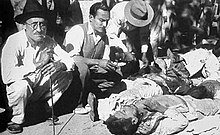

The history of El Salvador begins with several Mesoamerican nations, especially the Cuzcatlecs, as well as the Lenca and Maya. In the early 16th century, the Spanish Empire conquered the territory, incorporating it into the Viceroyalty of New Spain ruled from Mexico City. In 1821, El Salvador achieved independence from Spain as part of the First Mexican Empire, only to further secede as part of the Federal Republic of Central America two years later. Upon the republic's isolation in 1841, El Salvador became sovereign until forming a short-lived union with Honduras and Nicaragua called the Greater Republic of Central America, which lasted from 1895 to 1898.

The Farabundo Martí National Liberation Front is a left-wing political party in El Salvador.
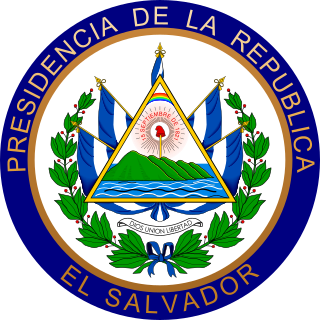
The president of El Salvador, officially titled President of the Republic of El Salvador, is the head of state and head of government of El Salvador. He is also, by constitutional law, the commander-in-chief of the Armed Forces of El Salvador. The office was created in the Constitution of 1841. From 1821 until 1841, the head of state of El Salvador was styled simply as Head of State.

Agustín Farabundo Martí Rodríguez was a Marxist-Leninist activist and a revolutionary leader in El Salvador during La Matanza.
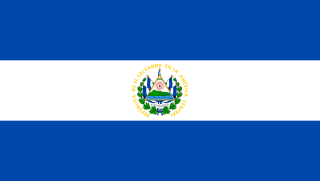
The Revolutionary Government Junta was the name of three consecutive joint civilian-military dictatorships that ruled El Salvador between 15 October 1979 and 2 May 1982.

Maximiliano Hernández Martínez was a Salvadoran military officer and politician who served as the president of El Salvador from 4 December 1931 to 28 August 1934 in an acting capacity and again in an official capacity from 1 March 1935 until his resignation on 9 May 1944. He was the leader of El Salvador during World War II. While he served as President Arturo Araujo's vice president and defense minister, a directorate seized power during a palace coup and afterwards named Hernández Martínez president of El Salvador.
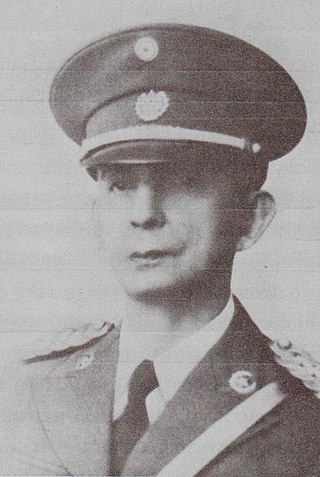
Osmín Aguirre y Salinas was a Salvadoran military officer and politician who served as the provisional president of El Salvador from 21 October 1944 until 1 March 1945. A Colonel in the Salvadoran Army, Aguirre y Salinas led two successful coups against the Salvadoran government: once in 1931 and again in 1944. He left office in 1945, with the assurance that his successor in the next election would be Salvador Castaneda Castro. He was later assassinated near his home in San Salvador at the age of 87.
Panchimal is a town in the San Salvador department of El Salvador.
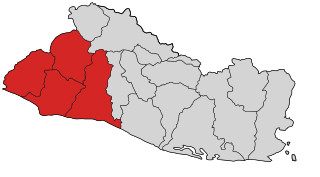
La Matanza refers to a communist-indigenous rebellion that took place in El Salvador between 22 and 25 January 1932. It was succeeded by large-scale government killings in western El Salvador, which resulted in the deaths of 10,000 to 40,000 people.
Concepción Quetzaltepeque is a municipality in the department of Chalatenango in the north of El Salvador. It is bordered to the north by Comalapa and La Laguna, to the east by Las Vueltas and Chalatenango, to the south by Chalatenango, and to the west by Santa Rita. The territorial extension of the municipality is 52.54 km2. In 2005 the population was 6,734 inhabitants. The municipality's administration is divided into 6 cantons and 14 caserío.
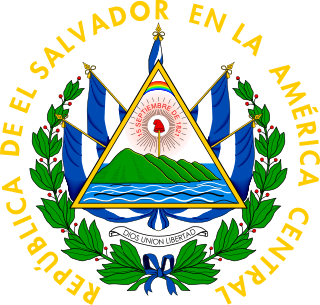
Legislative elections were held in El Salvador between 12 and 14 January 1932. The government had promised free and fair elections and invited all parties, including the Communist Party of El Salvador, to compete. However, voters had to be registered in their municipalities alongside their party, thus giving the government a list of Communist Party members. In the preceding municipal elections on 3–5 January, the Communists won several predominantly indigenous municipalities in the west of the country. However, the Maximiliano Hernández Martínez government cancelled the planned second round of the legislative and municipal elections due to the Communist success. The conservative Progressive Fraternal Party boycotted the elections in San Salvador on the grounds of electoral fraud.

Presidential elections were held in El Salvador between 13 and 15 January 1935. Maximiliano Hernández Martínez was the only candidate and was returned unopposed.

The Salvadoran military dictatorship was the period of time in Salvadoran history where the Salvadoran Armed Forces governed the country for almost 48 years from 2 December 1931 until 15 October 1979. The authoritarian military dictatorship limited political rights throughout the country and maintained its governance through rigged and fixed elections.

José Feliciano de Jesús Ama Trampa was an indigenous peasant leader, a Pipil from Izalco in El Salvador, who participated and died during La Matanza.
Mario Aguiñada Carranza was a Salvadoran activist and politician. He became politically active during his student years and joined the Communist Party of El Salvador. In the 1970s he became Secretary General of the Nationalist Democratic Union. During the Salvadoran Civil War he was on the side of the Farabundo Martí National Liberation Front and served as a diplomatic representative. Aguiñada Carranza was member of the Legislative Assembly of El Salvador between 1991 and 1994.
The 1979 Salvadoran coup d’état was a military coup d'état that occurred in El Salvador on 15 October 1979. The coup, led by young military officers, bloodlessly overthrew military President Carlos Humberto Romero and sent him into exile. The National Conciliation Party's firm grasp on power was cut, and in its place, the military established the Revolutionary Government Junta of El Salvador (JRG). The junta was composed of two military officers and three civilians.

The 1931 Salvadoran coup d'état occurred on 2 December 1931. The coup overthrew President Arturo Araujo and led to the establishment of the Civic Directory. The coup began 48 years of military rule in El Salvador which lasted until the 1979 Salvadoran coup d'état.
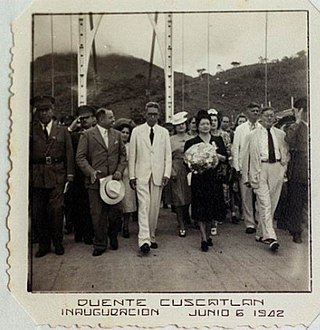
The Cuscatlán Bridge was a suspension bridge which spanned across the Lempa River in El Salvador. The bridge connected the departments of San Vicente and Usulután from its opening on 6 June 1942 until it was destroyed in a bombing by militants of the Farabundo Martí National Liberation Front on 1 January 1984 during the Salvadoran Civil War. The bridge used to be a part of the Pan-American Highway and was one of the major infrastructure projects ordered by President Maximiliano Hernández Martínez. After the bridge was destroyed, it was rebuilt in 1998 at the cost of 9 million dollars and it remains standing today.
Miguel Mármol was a Salvadoran communist activist and the founder of the Communist Party of El Salvador.
Anarchism in El Salvador reached its peak during the labour movement of the 1920s, in which anarcho-syndicalists played a leading role. The movement was subsequently suppressed by the military dictatorship before experiencing a resurgence in the 21st century.